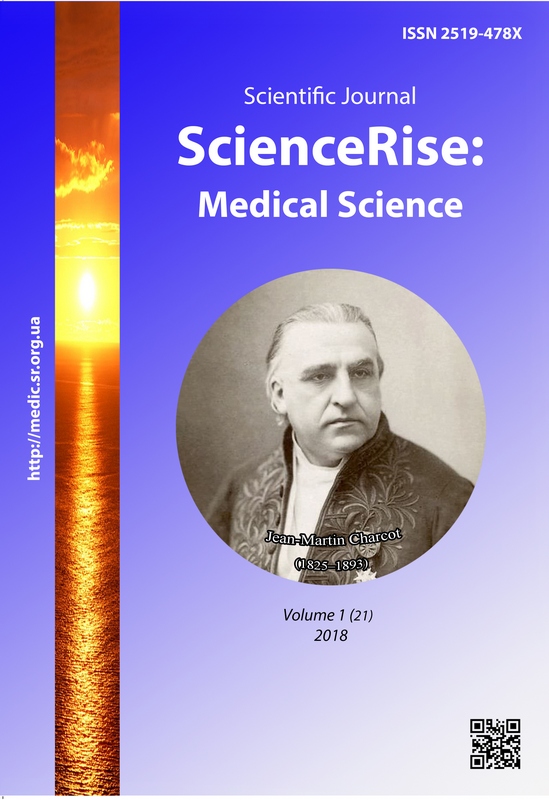Research of the colonization level of the fungi Malassezia spp. and Candida spp. on the skin of patients with skin diseases
DOI:
https://doi.org/10.15587/2519-4798.2018.121964Keywords:
Malassezia spp, Candida spp., colonization of the skin, the method of “bacterial swab test”, skin diseasesAbstract
The aim of the work was to research the skin colonization of Malassezia spp., and Candida spp. of the patients with skin diseases and healthy individuals by the method of “bacterial swab test”. The features of colonization of the skin of patients with skin diseases the fungi of the genus Malassezia, Candida and molds, which complicate of these diseases, are established.
Methods of the research. It has included 107 patients with skin diseases and 20 healthy individuals. For the study, sterile plastic Petri dishes (d=3.5 cm.) with Leeming-Notman agar were used. After 5 days of incubation, the numbers of colonies grown on the dish were counted. The identification was performed to the morphological, microscopic and tinctorial properties.
Results: The highest level of colonization (>20 CFU/10 cm2) on the intact skin of the fungi of the genus Malassezia were detected in patients with eczema and atopic dermatitis (18.6 % and 30 %), and in the “locus morbi” in 15 % and 25 % respectively. Candida spp. in quantity >20 CFU were detected in the patients with psoriasis (9.6 %) on “locus morbi”. Malassezia spp. was detected in 40 % healthy individuals, in quantity 10–15 CFU. Candida spp was not detected in healthy individuals.
Conclusions: The method of “bacterial swab test” was used to research the skin colonization of Malassezia spp., and Candida spp. of the patients with skin diseases and healthy individuals
References
- Aak, O. V. (2005). Allergeny gribov. Osobennosti mikogennoy sensibilizatsii (obzor). Problemy meditsinskoy mikologii, 7 (2), 12–16.
- White, T. C., Findley, K., Dawson, T. L., Scheynius, A., Boekhout, T., Cuomo, C. A. et. al. (2014). Fungi on the Skin: Dermatophytes and Malassezia. Cold Spring Harbor Perspectives in Medicine, 4 (8), a019802. doi: 10.1101/cshperspect.a019802
- Gaitanis, G., Magiatis, P., Hantschke, M., Bassukas, I. D., Velegraki, A. (2012). The Malassezia Genus in Skin and Systemic Diseases. Clinical Microbiology Reviews, 25 (1), 106–141. doi: 10.1128/cmr.00021-11
- Sharma, M., Sharma, R. (2011). Profile of Dermatophytic and Other Fungal Infections in Jaipur. Indian Journal of Microbiology, 52 (2), 270–274. doi: 10.1007/s12088-011-0217-z
- Fayzullina, Ye. V., Fayzullin, V. A., Brigadnova, A. Yu., Glushko, N. I. (2008). Mikoticheskaya kolonizatsiya pri oslozhnennykh formakh psoriaza. Klinicheskaya dermatologiya i venerologiya, 3, 32–34.
- Jagielski, T., Rup, E., Ziolkowska, A., Roeske, K., Macura, A. B., Bielecki, J. (2014). Distribution of Malassezia species on the skin of patients with atopic dermatitis, psoriasis, and healthy volunteers assessed by conventional and molecular identification methods. BMC Dermatology, 14 (1). doi: 10.1186/1471-5945-14-3
- Sokolova, T. V., Mokronosova, M. A., Klivitskaya, N. A. (2009). Osobennosti immunnogo otveta bol'nykh atopicheskim dermatitom pri sensibilizatsii lipofil'nymi drozhzhami Malassezia spp. i drozhzhepodobnymi gribami Candida spp. Immunopatologiya, allergologiya, infektologiya, 2, 99–100.
- Kadaner, Ye. I., Gorbuntsov, V. V., Mamon, A. A. (2016). Nekotoryye osobennosti kliniki i techeniya mikrobnoy ekzemy assotsiirovanoy s malasseziozom i papillomavirusnoy infektsiyey kozhi. Uspekhi meditsinskoy mikologi, XV, 110–113.
- Arzumanyan, V. G., Zaytseva, E.V., Kabayeva, T. I., Temper, R. M. (2004). Stafilokokkovoy i nelipofil'noy drozhzhevoy mikroflory kozhi u bol'nykh s kozhnoy patologiyey pri kontaktnom sposobe poseva. Vestnik dermatologii i venerologii, 6, 3–6.
- Tsyiganenko, A. Ya., Chastii, T. V. (2011). Mikrobiologicheskie osobennosti vyideleniya i dentifikatsii gribov roda Malassezia. Teoretichna i eksperimenalna meditsina, 4 (53), 5–8.
- Belozorov, A. P., Zuyeva, M. I., Chastii, T. V., Kutasevich, Ya. F., Mashtakova, I. A. (2011). Pokazateli sensibilizatsii k antigenam uslovno-patogennykh gribov Malassezia i Sandida u bol'nykh allergodermatozami s mutatsiyami gena filaggrina. Dermatologiya ta venerologiya, 4 (54), 27–32.
- Prohic, A., Jovovic Sadikovic, T., Krupalija-Fazlic, M., Kuskunovic-Vlahovljak, S. (2015). Malasseziaspecies in healthy skin and in dermatological conditions. International Journal of Dermatology, 55 (5), 494–504. doi: 10.1111/ijd.13116
- Batyrshina, S. V., Khayertdinova, L. A., Khalilova, R. G., Sabynina, E. E. (2013). Mikrobiotsenoz kozhi u bol'nykh atopicheskim dermatitom i yego korrektsiya. Prakticheskaya meditsina, 1-4 (73), 33–37.
- Bolotnaya, L. A. (2013). Profylaktyka bakteryalʹnykh oslozhnenyy pry atopycheskom dermatyte s yspolʹzovanyem sredstv na osnove termalʹnoy vody, medy y tsynka. Ukrayinsʹkyi zhurnal dermatolohiyi, venerolohiyi, kosmetolohiyi, 48, 94–101.
Downloads
Published
How to Cite
Issue
Section
License
Copyright (c) 2018 Tetiana Chastii

This work is licensed under a Creative Commons Attribution 4.0 International License.
Our journal abides by the Creative Commons CC BY copyright rights and permissions for open access journals.
Authors, who are published in this journal, agree to the following conditions:
1. The authors reserve the right to authorship of the work and pass the first publication right of this work to the journal under the terms of a Creative Commons CC BY, which allows others to freely distribute the published research with the obligatory reference to the authors of the original work and the first publication of the work in this journal.
2. The authors have the right to conclude separate supplement agreements that relate to non-exclusive work distribution in the form in which it has been published by the journal (for example, to upload the work to the online storage of the journal or publish it as part of a monograph), provided that the reference to the first publication of the work in this journal is included.









